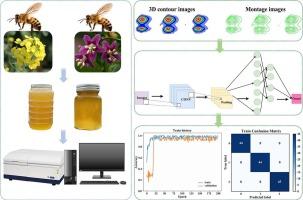基于canney - googlenet深度学习网络结合三维荧光光谱的两种单花蜂蜜真伪检测
IF 9.8
1区 农林科学
Q1 CHEMISTRY, APPLIED
引用次数: 0
摘要
为了确定蜂蜜的真伪,建立了基于canny-googlenet结构结合三维荧光光谱的深度学习网络。该边缘检测算法用于提取两种不同的单花蜂蜜,油菜蜂蜜和枸杞蜂蜜,以及掺入玉米糖浆或其他类型蜂蜜的蜂蜜样品的三维光谱数据。数据集分为训练集(133个样本)、验证集(33个样本)和测试集(12个样本)。通过优化block 2中的初始化模块,将l2正则化应用于改进的全连接层,并实现监控训练网络模型来减少过拟合并增强模型的鲁棒性,从而增强经典googlenet架构。最终模型在训练集上达到了大约100 %的准确率,在验证集上达到了93.7 %的准确率。这些结果表明,将三维荧光光谱与基于cnn的深度学习模型相结合,在蜂蜜认证方面具有重要的潜力。本文章由计算机程序翻译,如有差异,请以英文原文为准。


Detecting the authenticity of two monofloral honeys based on the Canny-GoogLeNet deep learning network combined with three-dimensional fluorescence spectroscopy
To determine the authenticity of honey, a deep learning network based on the Canny-GoogLeNet architecture combined with three-dimensional (3D) fluorescence spectroscopy was established. The canny edge detection algorithm was used to extract 3D spectral data from two distinct monofloral honeys, rape honey and wolfberry honey, as well as adulterated honey samples with corn syrup or other types of honey. The dataset was divided into training (133 samples), validation (33 samples), and test sets (12 samples). The classical GoogLeNet architecture was enhanced by optimizing the inception module in Block 2, applying L2 regularization to the improved fully-connected layer, and implementing a monitoring training network model to reduce overfitting and enhance model robustness. The final model achieved approximately 100 % accuracy on the training set and 93.7 % accuracy on the validation set. These results indicate that integrating 3D fluorescence spectra with a CNN-based deep learning model has significant potential for authenticating honey.
求助全文
通过发布文献求助,成功后即可免费获取论文全文。
去求助
来源期刊

Food Chemistry
工程技术-食品科技
CiteScore
16.30
自引率
10.20%
发文量
3130
审稿时长
122 days
期刊介绍:
Food Chemistry publishes original research papers dealing with the advancement of the chemistry and biochemistry of foods or the analytical methods/ approach used. All papers should focus on the novelty of the research carried out.
 求助内容:
求助内容: 应助结果提醒方式:
应助结果提醒方式:


